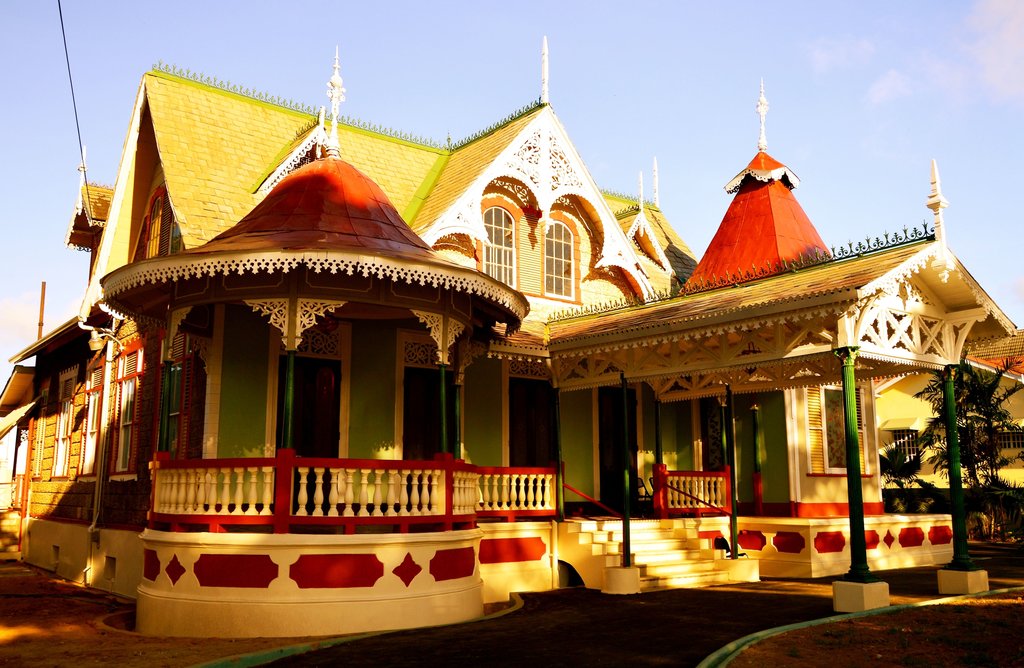|
The National Trust of Trinidad and Tobago recognized the restoration work on Boissiere House with an award in 2014.CreditCreditLiam Boodoo PORT OF SPAIN, Trinidad — After languishing for more than five years on the international real estate market, Boissiere House, a much-photographed dwelling also known as the Gingerbread House, has finally been bought and restored, and its owners have received a heritage award for the work done on the project.
The house was built in 1904 on the edge of the green space known as Queen’s Park Savannah by C.E.H. Boissière, a prominent businessman, and was long the home of mixed-race descendants of French merchants and plantation owners. In 2013 it was purchased by the Sammy family, wealthy Indo-Trinidadians who made their fortune in the island’s booming construction industry. The family patriarch, Junior Elgin Sammy, bought the house as a gift to himself for his 61st birthday. The Sammys took ownership in November 2013, and the renovation work began immediately, said Shivonne Sammy Maharaj, Mr. Sammy’s daughter. “We basically bought a dilapidated, broken shell and aimed to restore its magnificence,” Ms. Sammy Maharaj said in an email. “Our main challenge in the restoration would be to not break anything, not change anything and of course to not offend anyone with our decisions.” Though the Sammys declined to say how much they paid for the house, three years ago the asking price was 20 million Trinidadian dollars, or about $3.15 million. The work on the 3,500-square-foot house was carried out under the oversight of the heritage architect Rudylynn De Four Roberts, and was accomplished so effectively that the National Trust of Trinidad and Tobago recognized the project with a historic restoration award in 2014. The decision by Mr. Sammy to buy and renovate the house was a rare one on an island with little tradition of preserving its built heritage. Indeed, Ms. Roberts said buildings that are important to Trinidad and Tobago historically and culturally continue to be imperiled. She told the story of the Greyfriars Church of Scotland, a 19th-century building in Port of Spain that was bought last year by a businessman, who promptly moved to demolish it. The local group Citizens for Conservation, to which Ms. Roberts belongs, intervened and “was able to save that building,” she said. “Otherwise it would have come down.” For Mr. Sammy, the acquisition of Boissiere House was a childhood dream fulfilled. As Ms. Sammy Maharaj explained it, “as a young boy, my father would go for Sunday drives with his parents to Port of Spain, and always admired the historical majestic homes around the Queen’s Park Savannah. He imagined one day owning one of these homes, and as he grew his ambition of this never changed.” She said that the restoration of the house had been a family project involving her mother, Linda, her husband, Rajendra Maharaj, and all of her siblings, and that her father has asked his children to keep the house in the family as part of his legacy. Ms. Roberts said that although work still needed to be done on some aspects of the house, such as the fretwork on the roof that would require specialist joiners, “enough work was done to prevent and to halt further deterioration.” The house, which Ms. Roberts described as Arts and Crafts in style, with elements of West Indian vernacular architecture, is made of wood and stone. It has four bedrooms and two bathrooms, living and dining areas, a study and both indoor and outdoor kitchens. It also has a wraparound veranda, a classic of West Indian style, whose original mosaic pattern tiles of brown, cream and green have been retained. Other vernacular elements include Demerara and sash windows, and ornate fretwork above all the doors for ventilation. A dormer window that was meant to keep the attic timbers dry likewise enhances ventilation. The steep, pitched gable roof is decorated extensively with finials. The interior is painted in cream, with dark wood wainscoting and floors of polished cedar. Where the tops of the walls meet the ceilings there are cornice moldings, and a fancy chandelier in the living room hangs from a ceiling rose. In decorating the house, Ms. Sammy Maharaj said, “We wanted to relive the era of the house,” but “still needed it to be comfortable and livable.” Keeping that dual objective in mind, they have furnished the house with pieces collected from antiques shops in the United States and Britain, as well as some of her grandparents’ furniture. Originally published on March 26, 205 by Jewel Fraser, New York Times.
1 Comment
|
T&T news blogThe intent of this blog is to bring some news from home and other fun items. If you enjoy what you read, please leave us a comment.. Archives
May 2025
Categories
All
|


 RSS Feed
RSS Feed